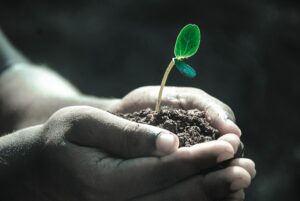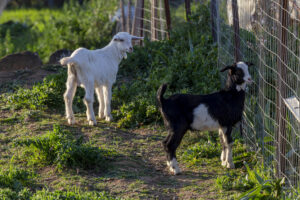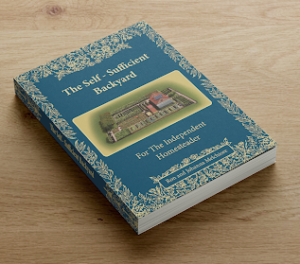Introduction:

If you have ever been on a typical farm, you may have noticed that there are resources that run through the entire property. These resources might include crops, animals, water sources, and other biological elements. Permaculture Principle Number Five: Biological Resources takes this to an entirely different level with the use of permaculture.
Permaculture is an approach to living in harmony and balance with nature that utilizes biological resources and natural ecological processes. The fifth principle of permaculture is the use of biological resources to help create a sustainable, self-sufficient environment. This principle applies whether you are looking at creating a small garden or managing an entire farm.
Using Biological Resources through Gardening
One way to use biological resources is through the creation of a permaculture garden. This type of garden uses living elements like plants, animals, fungi, and microbes to create a self-sustaining system. In this method, each element has a role to play in the overall health of the environment as it relates to energy, water, and nutrient cycles.
For example, certain plants can be used to fix nitrogen in the soil or provide shelter for other species. Animals such as chickens can be used to fertilize the soil and their eggs can provide a source of nutrition. Fungi can play an important role in decomposing organic matter which helps return nutrients into the soil. Finally, microbes can help bring life and fertility back into the soil.
By using biological resources in this way, permaculture practitioners are able to create a thriving environment that is self-sustaining and produces healthy food for both humans and animals. Additionally, this approach also helps preserve the natural biodiversity of an area which is important for long-term sustainability.

Food Forest anyone?
These principles can be applied to any environment or landscape, and the results will vary depending on what is already there and how it is managed. For example, if an area has a large number of trees, then you may want to focus on creating a food forest that utilizes the existing ecology rather than attempting to recreate something from scratch.
Piney River Homestead is a great example of how permaculture can be used to create a healthy and sustainable environment. The long-term plan for this small farm is to run it ourselves with much of our income coming from selling produce grown in our own gardens. We also plan to keep chickens for eggs, bees for honey, and other animals like maybe goats that help keep weeds down and will provide milk. Not sure about that one as you have to be there to milk daily.
By using the principles of permaculture, Piney River Homestead is providing a model for sustainable and regenerative living. We are actively engaging with our environment while also taking care of the land to ensure it will stay productive for years to come.
All the Parts Make a Whole
One key aspect of making sure this works is understanding how different elements work together in an ecosystem. For example, certain plants can provide food for the bees which in turn helps pollinate other plants, allowing them to grow and reproduce. We are learning how these different elements interact with each other to create a beneficial ecosystem that works in harmony with nature.
Jasper is our mascot at Piney River Homestead, and he loves taking walks around the property! He’s been able to experience first-hand the amazing transformation taking place as we transition to a sustainable lifestyle. He loves watching the bees buzzing around in search of nectar and seeing all the different fruits and vegetables growing in our gardens. It’s a sight he never gets tired of!
Piney River Homestead is an opportunity for you to come along with Jasper and explore our permaculture practices. Learn how you can use the power of nature to create a sustainable and fruitful lifestyle. You’ll be able to witness firsthand how our land has changed from when we first moved in, and what it takes to make an impact on the environment. Join us for this journey of discovery!
A Farm is not the Only Homestead
You don’t have to live on a farm or homestead just to be a part of this journey. By learning the principles of permaculture, you can implement these ideas in your backyard garden and make an impact on our planet. Start small with composting or growing native plants, then expand to larger projects such as rainwater harvesting or aquaponics systems. The possibilities are endless!
We invite you to come along for the ride and experience first-hand the transformation that permaculture can bring. Jasper is always happy to lend a hand in showing you the ropes, and we are sure you will be inspired to create your own sustainable lifestyle!
Together we can make a difference in protecting our planet from environmental degradation, so let’s get started! By understanding the principles of permaculture, implementing these practices in our own lives and sharing what we have learned with others, we can help create a more sustainable future. Join us as we take this journey toward a healthier and greener tomorrow!
Conclusion
Being a military brat I have been all around the country and outside it exploring different cultures and lifestyles, but I never felt more at home than I did when we moved to the farm and started our permaculture journey. Now, through Piney River Homestead, I want to share my experiences with others and inspire them to make a positive change in their own lives and take action for our planet! Come join me as we explore the wonders of nature and learn how by working together, anything is possible.
Together, we can create a better future for our planet and its inhabitants! Let’s embark on this journey of discovery together – come explore with us! Your help is essential in preserving this beautiful planet that we all inhabit, and together, we can make it happen. So let’s get started!
For more about permaculture principles check here.
Resource:

